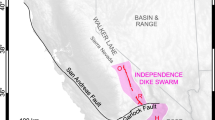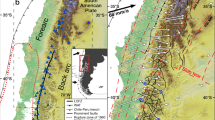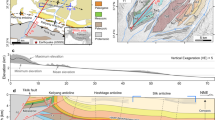Abstract
Arrays of parallel extension fractures and veins are sometimes associated with exhumed faults and seem to be the product of repeated hydro-fracturing under a shared stress regime. Here theoretical considerations are used to suggest that this type of hydro-fracture dilatancy is essentially a low differential stress phenomenon. It may develop under hydrostatic fluid pressures around normal faults at shallow depths, but can only occur in association with thrusts when fluid pressures exceed the litho-static load. This contrasts with most existing models for dilatancy, where the effects only become pronounced at high stress levels and are best developed around thrust faults.
This is a preview of subscription content, access via your institution
Access options
Subscribe to this journal
Receive 51 print issues and online access
$199.00 per year
only $3.90 per issue
Buy this article
- Purchase on Springer Link
- Instant access to full article PDF
Prices may be subject to local taxes which are calculated during checkout
Similar content being viewed by others
References
Nur, A. Bull. seism. Soc. Am. 62, 1217–1222 (1972).
Scholz, C. H., Sykes, L. R. & Aggarwal, Y. P. Science 181, 803–810 (1973).
Mjachkin, V. I., Brace, W. F., Sobolev, G. A. & Dieterich, J. H. Pure appl. Geophys. 113, 169–181 (1975).
Nur, A. Pure appl. Geophys. 133, 197–206 (1975).
Sibson, R. H. Nature 249, 542–544 (1974).
Nur, A., Bell, M. L. & Talwani, P. Proc. Conf. on Tectonic Problems of the San Andreas Fault System Vol. 13, 391–404 (Stanford University, 1973).
Vita-Finzi, C. Geol. Min. Surv. Iran Rep. 47 (1979).
Cloos, E. Proc. natn. Acad. Sci. U.S.A. 18, 387–395 (1932).
Dennis, J. G. Am. Ass. petrol. Geol. Mem. 7, 95–96 (1967).
Durney, D. W. & Ramsay, J. G. in Gravity and Tectonics (eds De Jong, K. A. & Scholten, R.) 67–96 (Wiley, New York, 1973).
Ramsay, J. G. Nature 284, 135–139 (1980).
Grindley, G. W. & Browne, P. R. L. Proc. 2nd U.N. Symp. on Development and Use of Geothermal Resources 377–386 (New York, 1976).
Secor, D. T. Am. J. Sci. 263, 633–646 (1965).
Heard, H. C. & Rubey, W. W. Bull. geol. Soc. Am. 77, 741–760 (1966).
Sibson, R. H. J. geol. Soc. Lond. 133, 191–213 (1977).
Hubbert, M. K. & Rubey, W. W. Bull. geol. Soc. Am. 70, 115–166 (1959).
Hoek, E. & Bray, J. W. Rock Slope Engineering (Institute of Mining and Metallurgy, London, 1977).
Patterson, M. S. Experimental Rock Deformation–The Brittle Field (Springer, Berlin, 1978).
Anderson, E. M. The Dynamics of Faulting (Oliver & Boyd, Edinburgh, 1951).
Hubbert, M. K. & Willis, D. G. Trans. Am. Inst. Min. Engr. 210, 153–168 (1957).
Abdallah, A. et al. Nature 282, 17–23 (1979).
Narasimhan, T. N., Houston, W. N. & Nur, A. M. Geology 8, 349–351 (1980).
Author information
Authors and Affiliations
Rights and permissions
About this article
Cite this article
Sibson, R. Controls on low-stress hydro-fracture dilatancy in thrust, wrench and normal fault terrains. Nature 289, 665–667 (1981). https://doi.org/10.1038/289665a0
Received:
Accepted:
Issue Date:
DOI: https://doi.org/10.1038/289665a0
This article is cited by
-
Microstructural characterization of natural fractures and faults in the Opalinus Clay: insights from a deep drilling campaign across central northern Switzerland
Swiss Journal of Geosciences (2023)
-
Soft-sediment deformation structures in NW Germany caused by Late Pleistocene seismicity
International Journal of Earth Sciences (2013)
-
The potential influence of shallow gas and gas hydrates on sea floor erosion of Rock Garden, an uplifted ridge offshore of New Zealand
Geo-Marine Letters (2010)
-
Geological record of fluid flow and seismogenesis along an erosive subducting plate boundary
Nature (2008)
-
Numerical simulation of groundwater flow in the Peshawar intermontane basin, northwest Himalayas
Hydrogeology Journal (2008)
Comments
By submitting a comment you agree to abide by our Terms and Community Guidelines. If you find something abusive or that does not comply with our terms or guidelines please flag it as inappropriate.



